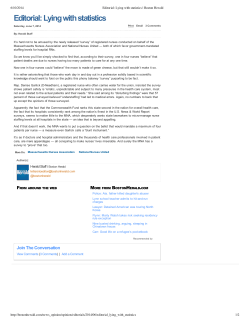
PITYRIASIS ROSEA
PITYRIASIS ROSEA What are the aims of this leaflet? This leaflet has been written to help you understand more about pityriasis rosea. It tells you what it is, what causes it, what can be done about it, and where you can find out more about it. What is pityriasis rosea? Pityriasis rosea is a common and harmless rash that goes away by itself after about 8 weeks. Its name means that the rash is scaly (pityriasis) and pink (rosea). What causes it? The cause of pityriasis rosea is still not known. It may be due a reaction to a harmless virus as it occurs in clusters and is most common in the winter. The risk of passing it on to anyone else seems to be very low. It is most common between the ages of 10 and 35 years. Is pityriasis rosea hereditary? No. What are its symptoms? You may have a mild headache, and feel unwell just before the rash comes up, or even when the rash is present. The rash can be itchy. What does pityriasis rosea look like? The first sign of pityriasis rosea is a single patch, which is known as a ‘herald 4 Fitzroy Square, London W1T 5HQ Tel: 020 7383 0266 Fax: 020 7388 5263 e-mail: admin@bad.org.uk Registered Charity No. 258474 patch’ because it comes up a few days, or even a couple of weeks, before the rest of the rash. A ‘herald patch’ is: · Usually single. · Usually on the main part of the body (trunk). · Larger (2 to 5 centimeters across) than the other patches that come up later. · Round or oval and, at first, bright red, and scaly. Later it becomes paler with a ring of scaling (known as a collarette) just inside its edge. A few days after the herald patch has appeared a different type of rash appears: · It is made up of many small oval patches (1 to 2 centimeters across). · They are pink and, like the herald patch, they may also have a ring of scaling just inside their edge. · Most of these patches will be on the trunk, but some may come up on the limbs and neck too. · On the trunk, these patches take up what is known as a ‘Christmas tree pattern’. This means that the oval pink areas line up in such a way that they run downwards and outwards from the centre, in much the same way that the branches of a Christmas tree run downwards and outwards from the trunk. · They come up in crops, at intervals of a few days, for a week or two and then fade slowly over the next 6 to 8 weeks, usually leaving no trace. They may leave light or dark patches in people with a dark skin, but these marks do eventually fade. Second attacks are rare. How will it be diagnosed? There are no diagnostic tests for pityriasis rosea, but the story of a herald patch and the appearance of the rash will usually be enough for your doctor to make the diagnosis. If there is any doubt, or the rash lasts longer than two months, your doctor may want to do a skin biopsy (take a piece of your skin under local anaesthesia) and send it to the laboratory to rule out other rashes that can look rather like pityriasis rosea. The herald patch can sometimes be mistaken for an area of ringworm, and your doctor may wish to check this by sending a skin scraping to the laboratory. Can it be cured? Pityriasis rosea goes away by itself and treatment does little to speed this up. 4 Fitzroy Square, London W1T 5HQ Tel: 020 7383 0266 Fax: 020 7388 5263 e-mail: admin@bad.org.uk Registered Charity No. 258474 How can it be treated? Usually no treatment is needed. Antihistamines or a mild corticosteroid such as hydrocortisone cream or moisturising cream may help if the rash is itchy and extensive. If the itching is still severe despite these treatments, your doctor may suggest a stronger steroid cream or treatment with ultraviolet light. What can I do? · · · Remember that the story given above is right in most cases, but there may be variations on the theme. Occasionally a herald patch does not turn up, or two or three herald patches may crop up at the same time. Sometimes the widespread rash can last for as long as 3 months. If it is still not clearing at that stage, consult your doctor again. There is no reason to keep children with pityriasis rosea away from school. There is no need for treatment if the rash does not bother you. Where can I get more information about it? Web links to detailed articles and leaflets: www.aad.org/pamphlets/pityrias.html www.emedicine.com/derm/topic335.htm http://www.dermnetnz.org/viral/pityriasis-rosea.html This leaflet aims to provide accurate information about the subject and is a consensus of the views held by representatives of the British Association of Dermatologists: its contents, however, may occasionally differ from the advice given to you by your doctor. This leaflet has been assessed for readability by the British Association of Dermatologists’ Patient Information Lay Review Panel BRITISH ASSOCIATION OF DERMATOLOGISTS PATIENT INFORMATION LEAFLET PRODUCED MAY 2008 UPDATED AUGUST 2011 REVIEW DATE AUGUST 2014 4 Fitzroy Square, London W1T 5HQ Tel: 020 7383 0266 Fax: 020 7388 5263 e-mail: admin@bad.org.uk Registered Charity No. 258474
© Copyright 2025



















